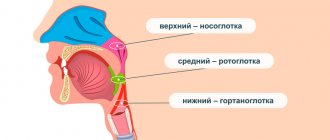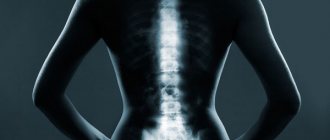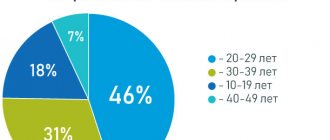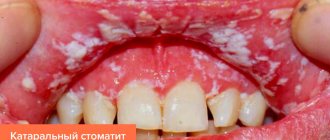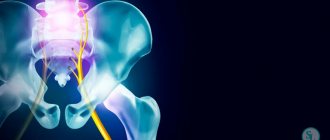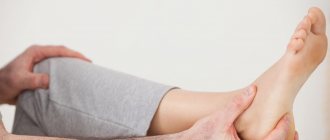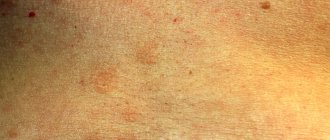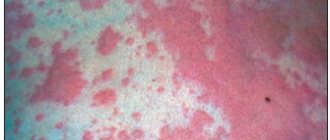Coccyx pain, called coccygodynia or anococcygeal pain syndrome, is a consequence of damage to bone and cartilage tissue, fibromuscular and/or nervous structures.
Painful sensations vary in nature and can last for several days/weeks or haunt a person from time to time throughout his life. Women aged 40-60 years of age are more often susceptible to chronic pathology due to the slightly different structure of the pelvis compared to men.
In most cases, pain in the tailbone is not dangerous to health, but it significantly reduces the quality of life, leads to sleep disturbances, decreased physical activity, depression and other unpleasant consequences.
Treatment of coccyx pain is conservative and consists of drug therapy with concomitant physiotherapy and massage.
According to the International Classification of Diseases (ICD-10), coccydynia is assigned the code M53.3. It refers to diseases of the musculoskeletal system and connective tissues, sacrococcygeal disorders, not classified elsewhere.
Symptoms of pain in the tailbone
Pain in the coccyx has a variety of manifestations. They can be aching, convulsive, sharp, braining, burning, pulling, bursting, etc. They often radiate to the sacral, gluteal region, genitals, and thighs.
When changing body position, the intensity of pain decreases or disappears without taking painkillers. Attacks can be either rare and mild or frequent and painful. There may be constant negative sensations over a long period of time, which are characterized by a sudden beginning and the same ending.
In most cases, attacks occur at night, during sneezing, coughing, physical stress, sports training, or intimacy. Pain in the coccyx is most severe when sitting on hard surfaces and decreases when walking. Gases and feces put pressure on the rectum, so bowel movements are sometimes painful, followed by temporary relief.
Localization of pain
The main symptom of coccydynia is pain, which is localized in the following places.
- Directly in the tailbone. As a rule, pain in the tailbone occurs when sitting, standing up and bending. It intensifies with strong pressure on the lower spine and after physical activity.
- In the anus. Pain occurs suddenly, mainly at night or during sexual intercourse, as well as during bowel movements.
Movements become constrained and cautious, the gait becomes slow and waddles (like a duck). This is fraught with scoliotic changes in the spinal column, joint deformation, and muscle strain. It is possible that constipation, difficulties with deurination, and sexual dysfunction may occur. The result is a deterioration in the emotional state: the emergence of fears, irritability, depression, fatigue, insomnia.
Possible autonomic reactions of the body to pain in the tailbone: increased sweating, peripheral incoming vasospasm (vasospasm), intestinal upset, vomiting.
The disease is characterized by a chronic course. It worsens mainly in the autumn-winter period, after stressful situations, general hypothermia, excessive or unusual physical activity.
If the cause of pain in the coccyx is an injury, the pain syndrome is severe, and the appearance of hematomas, swelling and swelling in the damaged area cannot be ruled out.
Physical therapy
Patients with coccydynia are initially advised to avoid triggers. Initial interventions include using donut pillows or a gel pad when sitting for long periods of time. This reduces local pressure and improves the patient's posture. However, there is no evidence that these minor changes reduce patient complaints.
Methods of physical therapy for coccydynia will be discussed in detail at the seminar “Women’s health: opportunities for restorative fitness and physical therapy.”
Mobilizations
Mobilizations can be used to correct the position of the coccyx. The first choice for mobilization is posterior-anterior central pressure (soft oscillations). If this is painful, you can start with rotational mobilization - it is recommended to mobilize in only one direction at a time.
Another option for manual therapy is the use of deep transverse frictions in relation to the affected ligaments. The patient lies in the prone position with a pillow under the pelvis and hips in slight abduction and internal rotation. The therapist places his thumb on the affected area and, depending on the location of the lesion, performs deep transverse frictions.
Manipulation
Coccyx manipulation can be performed intrarectally with the patient in the lateral decubitus position. With the index finger, the tailbone is repeatedly bent and unbent. This is only done for one minute to avoid damaging or irritating the rectal mucosa.
Massage
Massaging the levator ani muscles has been found to relieve pain. To eliminate the possibility of the muscles pulling on the tailbone, relaxation of the pelvic floor muscles can be integrated using biofeedback.
Causes of pain in the tailbone
The coccyx is the lower part of the spinal column, consists of 4-5 rudimentary vertebrae that connect cartilaginous plates. In appearance, it resembles a curved pyramid, the base of which is directed upward. Refers to rudimentary organs that are not endowed with independent functions; in mammals, the coccygeal bone is necessary to support the tail.
In the modern human body, the coccyx is needed for:
- attachment of muscles and ligaments necessary for the support and normal functioning of the abdominal organs (bladder, vagina, rectum, uterus, prostate gland);
- partial fixation of the gluteus maximus muscle;
- providing additional support during squats, bends and other movements;
- correct distribution of loads on the spinal column, etc.
Pain in the tailbone is the result of muscle spasm of the pelvic floor, as a reaction to:
- mechanical damage;
- diseases of the pelvic organs;
- degenerative-dystrophic changes in the intervertebral discs and spinal column.
With prolonged muscle spasm, the development of secondary changes in the muscles and ligaments is observed, they become thickened and shortened (with the formation of fibrosis, contracture). These processes lead to tissue tension, pinching (compression) of nerve fibers and pain in the tailbone.
Forms of coccydynia
Pain symptoms come in two forms.
- Primary. The causes of pain in the coccyx are traumatic injuries and diseases of the immediate lower part of the spinal column.
- Secondary. The pain is caused by inflammatory processes in the pelvic area, prostate gland, and rectum.
The birth of a large child can cause injury to a woman’s tailbone. In most cases, its damage is due to the following reasons.
- Cracks - clinical manifestations are identical to other injuries. To find out why the tailbone hurts, an x-ray diagnosis is necessary.
- Fractures – occur in rare cases. Damage mainly affects the sacrococcygeal joint, the most vulnerable area. In addition to the usual symptoms, it is accompanied by crepitation - a characteristic crunching sound, a crunching sound in the damaged area upon palpation.
- Dislocations and subluxations.
- Injuries, stretch marks, rupture of the sacrococcygeal ligaments.
Traumatic injuries do not pose a threat to life, however, they pose a risk of long-term consequences:
- formation of tumor neoplasms, fistulas, cysts, abscesses, complicated hematoma;
- pain during bowel movements, constipation;
- malfunctions of internal organs;
- post-traumatic chronic pain;
- complete or partial loss of sensitivity during sexual intercourse;
- migraines, neurological diseases;
- callus, immobility of the lower extremities.
After an injury, visiting a doctor is necessary if:
- temperature increase;
- loss of motor activity;
- clouding of consciousness;
- unbearable pain syndrome.
Coccydynia can be a consequence of tumor processes directly in the coccyx: teratoma, as well as osteosarcoma and chonrosarcoma - malignant neoplasms that require urgent treatment. Painkillers are not able to cope with intense pain.
A coccyx cyst is a congenital pathology. It is a canal lined with epithelial tissue containing hair follicles and sebaceous glands. It opens on the skin in the intergluteal fold in the form of one or several pinholes. Under normal conditions it does not cause negative sensations. The entry of skin particles and sebaceous gland secretions into the canal leads to the development of inflammatory processes and the formation of a fistula. In addition to pain in the tailbone, the pathology is accompanied by:
- lump formation;
- redness of the affected area;
- increased body temperature;
- deterioration in general health.
In this case, the only treatment for pain in the tailbone is surgery. The surgeon eliminates the main source of inflammation: the epithelial canal, holes, altered surrounding tissues, secondary fistulas.
Coccyx pain can also be caused by:
- muscular inflammation of the pelvic floor;
- chronic constipation;
- excessive body weight due to increased pressure on the spinal column;
- low weight due to insufficient fat layer on the buttocks;
- age-related changes;
- scar changes (including after surgery);
- flat feet, other foot deformities;
- multiple pregnancy, complicated pregnancy, difficult childbirth;
- osteochondrosis, degenerative changes in the cartilage tissues of the discs;
- insufficient physical activity.
Causes of pain in the coccyx also include the presence of pathological processes in organs and systems that do not belong to the lower part of the spine. Painful sensations from hemorrhoids, cystitis, urethritis, colpitis and other diseases only radiate into it.
If it is not possible to find out why the tailbone hurts, an idiopathic form of coccydynia is diagnosed.
Final indicators
Pain level assessment
- 4-dimensional pain intensity index (P4).
- Brief pain questionnaire.
- Numerical pain rating scale.
- Brief McGill Pain Questionnaire.
- Visual analog scale.
Level of function in daily life
- Pain Disability Index (Oswestry).
Specific questionnaires
- Pelvic floor questionnaire.
- Questionnaire for assessing the pelvic girdle.
Diagnosis of pain in the coccyx
For many people, coccydynia is not a reason to seek medical help. They simply do not pay attention to its clinical manifestations or try to eliminate them using folk methods. However, pain can be caused by life-threatening diseases, including malignant tumors, the treatment of which is successful only in the early stages.
A specialized specialist will conduct a diagnosis, find out why the tailbone hurts and prescribe the optimal treatment regimen.
If you experience pain in the lower spine, you should consult a neurologist. At the first appointment, the specialist’s task includes examining the patient and palpating the affected area. It is also necessary to collect an anamnesis by asking a person about past illnesses, surgical interventions, and traumatic injuries.
The patient is then referred to:
- laboratory tests (blood, urine);
- radiography to detect changes in bone structure, fractures, bruises, cracks, separation of the coccyx from the joint, rupture of intervertebral cartilage and other injuries;
- computer and magnetic resonance imaging are the most effective methods that will help determine not only the condition of bones, but also soft tissues, blood vessels, cartilage, and intervertebral discs. The specialist has the opportunity to obtain clear information about all pathological changes, the presence of tumors, their exact location and impact on nearby structures;
- Ultrasound refers to a typical examination that is prescribed for the diagnosis of coccydynia.
- sigmoidoscopy is an endoscopic examination prescribed to detect hemorrhoids, polyps, and inflammatory processes.
Possible purpose:
- myelogram – morphological analysis of bone marrow cells in cases of suspected hemoblastosis and metastases of malignant tumors;
- densitometry - which allows you to determine the density and likelihood of damage to bone tissue;
- irrigography - X-ray examination of the intestines. When it is carried out, a contrast agent is used;
- evacuation proctography - x-ray examination for visual assessment of rectal emptying;
It is possible to schedule a consultation with a proctologist, urologist, gynecologist, oncologist, or traumatologist to identify pathologies in their area.
Treatment methods for pain in the coccyx
Treatment of pain in the tailbone requires an integrated approach and consists not only of eliminating painful sensations, but also getting rid of the cause that led to them. The course of treatment is quite long.
Thus, in case of traumatic injuries, rest is required; hot baths and uncomfortable actions are prohibited. The condition will be improved by an orthopedic pillow.
Treatment of bruises will take approximately 1-1.5 months, uncomplicated fractures - about six months.
Fractures require bed rest with the installation of a fixing corset, splint, or plaster. If the spinal canal or nerve plexuses are damaged, the help of a neurologist is necessary.
Treatment of pain in the tailbone, regardless of its cause, includes:
- Including foods that prevent constipation in your diet: spinach, apples, prunes, walnuts, figs and others.
- If necessary, use orthopedic furniture and special devices to reduce pressure on the lower spine. So, if pain occurs in the tailbone when sitting, it is recommended to place a soft pillow under the buttocks.
Basically, treatment of pain in the coccyx is carried out with the help of drug therapy, physiotherapy, and surgery.
Drug therapy
When treating coccydynia, it is advisable to prescribe:
- non-steroidal anti-inflammatory drugs to eliminate pain and inflammation;
- muscle relaxants - specific medications to reduce the tone of skeletal muscles;
- local anesthetics in the form of creams, ointments, gels;
- microenemas and rectal suppositories to normalize intestinal function;
- antibiotics, in the presence of an infectious process;
- antidepressants to normalize the psycho-emotional state;
- immunostimulants to increase the body's protective functions and activate regenerative processes.
Chondroprotectors containing proteins necessary for articular cartilage, bone tissue and the entire musculoskeletal system are highly effective. Artracam demonstrated high efficiency. It is prescribed as part of complex therapy and as a preventive, supportive agent to strengthen the musculoskeletal system. Its mostly natural ingredients have virtually no side effects or contraindications.
Operation
The surgical treatment method is optimal for serious traumatic injuries:
- injury to a nearby organ;
- displacement, formation of fragments;
- extensive internal hemorrhage;
- improper fusion of tissues after fractures.
The need for complete or partial removal of the coccyx occurs in rare cases. The operation involves local frequency exposure (radiofrequency ablation).
Evidence base
- Stretching the piriformis and iliopsoas muscles, as well as Maitland rhythmic oscillatory chest mobilization for 3 weeks (5 sessions per week) showed a significant improvement in pain threshold.
- Extracorporeal shock wave therapy was more effective and acceptable in reducing the discomfort and disability caused by coccydynia than the use of other physical methods. Thus, it has been recommended as an alternative treatment option for patients with coccydynia.
- A combination of manipulation and corticosteroid injections was more effective in treating coccydynia compared with manipulation or corticosteroid injections alone. Patients who underwent treatment were completely free of pain at the end of the year.
- 16% of patients (Wray) had a positive effect from short-wave diathermy.

